
DDR5 Infinity Fabric, IMC, Timings Tuning …
Quickly find the right tuning with benchmark results …
More DDR5 tuning
Infinity Fabric tuning
IMC tuning
Memory timings tuning
DDR5 Benchmark general overview
More DDR5 Tuning …
Before we tackle the next steps in tuning the RAM, we would like to clarify a few basic things in advance.
On the previous page we showed what you can achieve with the XMP profile or EXPO profile selection. Here we show you how to optimize the most important parameters on a system with a Ryzen 7000/9000 processor with 6-8 cores without using a high-end RAM kit. High-end RAM in combination with a 16-core processor can achieve even more performance than we will show here. Our guide shows in the following steps how any AMD Ryzen 7000/9000 system can be noticeably optimized without having to spend exorbitant amounts of money. But even if you have purchased an expensive EXPO RAM kit, we recommend making the following settings, as some of the following values remain untouched by the EXPO profile or are still set with a large safety margin. In addition, there is no need to spend days or weeks testing every single memory timing, as we will only deal with the most important parameters. However, this means that we achieve 98-99% of a fully utilized system and limit the workload to a few hours, which can easily be spent on a rainy weekend.
Infinity Fabric tuning …
The Infinity Fabric connects the IO die with the core complex die in Ryzen 7000/9000 processors. You could also call it the data highway between RAM and computing cores. Optimizing or tuning this connection can therefore do no harm 😉
Most Ryzen 7000/9000 processors can operate the IF stably at 2133 to 2167 MHz. However, the SOC voltage (Vsoc) should be increased to 1.3V for this. There are several screenshots in various computer forums where the IF is operated at 2200MHz. These screenshots should be treated with caution. The IF works with an error correction, which can prevent program crashes in the limit range, but this condition is not recommended. We therefore recommend an IFC of 2167 MHz at Vsoc=1.3V. This should work for most processors. We recommend Prime95 Large FFT as a stress test, as this stress test places an extremely high load on the IF. The following ZenTimings screenshot shows the pimped IFC (FCLK) with 2167 MHz and the increased SOC voltage.
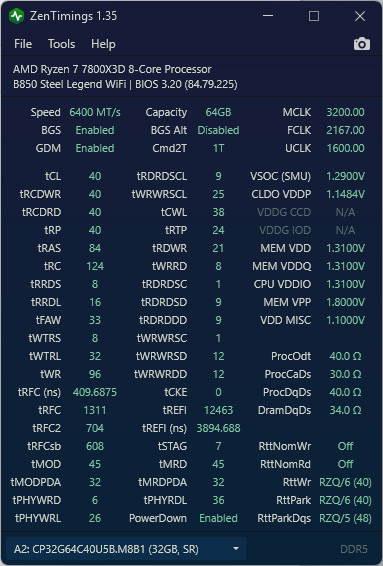
And here are the new measured values again in relation to the original initial values with DDR5-5200.
Benchmark values EXPO-6400 with IFC 2167 MHz …
AIDA Cache & Memory Benchmark
Read rate: 61,700 MB/s (+25%)
Write rate: 79,510 MB/s (+21%)
Copy rate: 61,390 MB/s (+24%)
Latency: 81.5 ns (-13%)
The write and copy rates of AIDA64 are now significantly higher than only after activating the EXPO profile. The latency has also improved slightly.
The gaming benchmark delivered the following score.
Time Spy CPU-Score: 12.438 Points (+8%)
The gaming benchmark also benefits from the increased clock rate of the IF and is now already a respectable 8% above the initial value.
Ryzen DRAM-Calc Benchmark: 84.7 seconds (-16%)
cThe benchmark of the Ryzen DRAM Calculator was also completed a little faster again and now runs 16% faster than originally.
Although we have already been able to achieve considerable improvements, we are continuing our work and will next turn our attention to the processor’s integrated memory controller (IMC).
IMC tuning …
For inexpensive memory kits, we recommend determining the maximum memory clock in 1:1 mode (UCLK = MCLK). We tried to run our test memory at 6400MT/s in 1:1 mode, but unfortunately the memory controller of our Ryzen 7800X3D processor refused. We therefore reduced the memory speed to 6200MT/s and were fortunately no longer able to detect any problems.
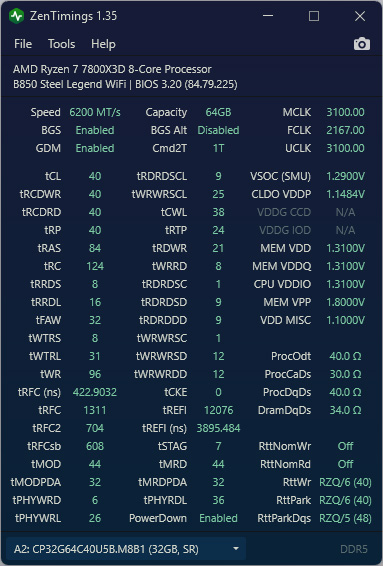
Benchmark values DDR5-6200 1:1 with IFC 2167 MHz …
AIDA Cache & Memory Benchmark
Read rate: 61,480 MB/s (+24%)
Write rate: 78,720 MB/s (+20%)
Copy rate: 61,430 MB/s (+24%)
Latency: 79.5 ns (-15%)
The AIDA64 benchmark shows minimally reduced bandwidths due to the slightly reduced clock frequency, but this is hardly noticeable. However, the latency was again reduced by 2 ns, which is not to be sneezed at and is now already 15% below the original value.
The gaming benchmark delivered the following score with DDR5-6200 in 1:1 mode.
Time Spy CPU-Score: 12.374 Points (+8%)
The score of the 3D Mark Time Spy CPU test drops by a few tenths of a percentage point compared to the previous measurement, but is still 8% above the initial value, which is a good basis for the following optimizations.
Ryzen DRAM-Calc Benchmark: 84.2 seconds (-17%)
The Ryzen DRAM-Calc benchmark apparently benefits more from the reduced latency than it is slowed down by the minimal bandwidth losses. We have now been able to gain 17% performance in this benchmark.
Next, we optimize a few memory timings that are significant for DDR5.
Tuning memory timings …
With DDR5, the refresh interval (tREFI) has a major influence on the performance of the RAM. The higher the value of tREFI is set in the BIOS DRAM timing menu, the less frequently a memory cell needs to be refreshed. Refresh cycles are necessary on a regular basis so that the memory cell retains its value. If a memory cell is refreshed, it cannot contribute to the calculation of data, which means that each refresh cycle slows down the PC. The reduced refresh cycles therefore automatically increase the memory performance. The initial value of tREFI in our case is 10126 cycles or 3895 ns. The maximum permissible value is 65535, but unfortunately our Crucial test memory could not reach this value. Our stable maximum value is 62000, which is a significant improvement on the initial value and the difference in performance compared to 65535 is negligible. If you start your overclocking attempts with tREFI 60000, you are not taking any great risks and will not lose any significant performance. The following benchmarks show just how big the gains are.
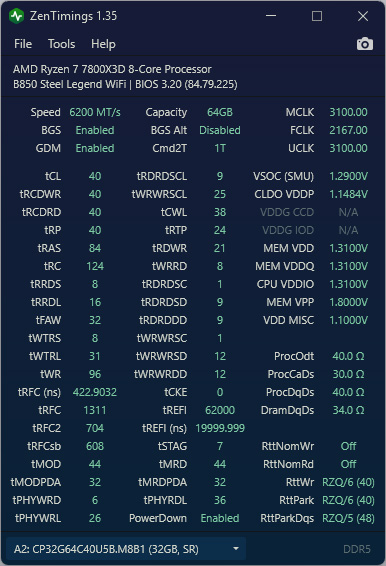
Benchmark values DDR5-6200 1:1 IFC2167 tREFI …
AIDA Cache & Memory Benchmark
Read rate: 67,540 MB/s (+37%)
Write rate: 87,060 MB/s (+32%)
Copy rate: 67,240 MB/s (+36%)
Latency: 68 ns (-27%)
After the optimization of tREFI, the AIDA measured values go through the roof. The performance gains achieved to date have been increased by a further 50%. Each AIDA measured value is now at least 27% better than the initial measurement with DDR5-5200.
The following score is now achieved in the gaming benchmark.
Time Spy CPU-Score: 12.839 Points (+12%)
The Time Spy CPU benchmark also benefits noticeably from the reduced refresh interval and now delivers 12% more points than at the beginning. Here, too, the performance gain was increased by a further 50%.
Ryzen DRAM-Calc Benchmark: 76.6 seconds (-24%)
The throughput time of the Ryzen DRAM Calculator benchmark also fell significantly by a further 7% and is now 24% below the initial value.
All in all, we achieved the biggest increase in performance to date with the tREFI tuning, but there is still more to come! Next, we will look at the timing tWR. It significantly influences the write performance of the working memory. The initial value of tWR is 96 and can normally always be reduced to 48. Even with DDR5-8000, tWR can normally be reduced to 48.
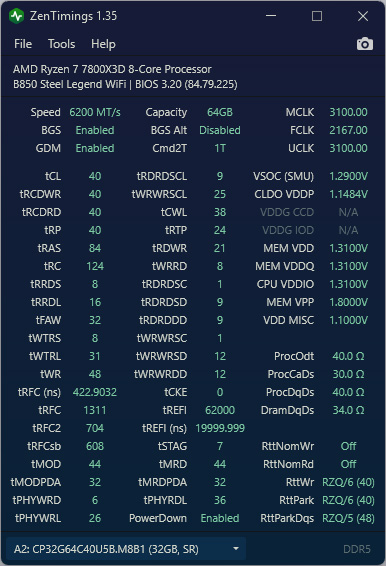
Benchmark values DDR5-6200 1:1 IFC2167 tREFI tWR …
AIDA Cache & Memory Benchmark
Read rate: 67,520 MB/s (+37%)
Write rate: 90,790 MB/s (+38%)
Copy rate: 67,420 MB/s (+36%)
Latency: 68 ns (-27%)
Thanks to the optimization of tWR, the write rate in the AIDA benchmark increased by a further 6% and is now an incredible 38% above the initial value. The read rate is already close to the limit of the Infinity Fabric. The copy rate also increased slightly, but also has practically no room for improvement because the IF is now almost exhausted. The latency remains unchanged at a good 68 ns.
The following score is now achieved in the gaming benchmark.
Time Spy CPU-Score: 13.179 Points (+15%)
The Time Spy CPU score has also increased significantly and is now 15% higher than the initial value, which can contribute to a significantly improved gaming experience in CPU-limited games.
Ryzen DRAM-Calc Benchmark: 74 seconds (-27%)
The Ryzen DRAM-Calc benchmark also benefits from the increased write performance of the RAM and once again runs 2.6 seconds faster than before. This means that it is now completed 27% faster than at the start of our measurements.
As things stand, the performance gains in memory-sensitive tests are between 15% and an incredible 38% compared to DDR5-5200.
The small number of changes also keeps the testing effort and the risk of instability to a minimum. However, the relevant values for inexpensive memory kits have already been exhausted. Even with a memory kit with the best chips in the world, you can’t do much more than reduce the memory latency by a few ns. The additional effort for further tuning would be very high and the possible gains are small, which is why we would like to conclude our recommendations for memory optimization with this.
The optimizations listed so far should be possible with all DDR5 memory kits on Ryzen 7000/9000 systems and offer a great increase in performance with little time expenditure. Of course, we still pushed our Crucial memory kit to the limit and of course we also want to present these values. A total of 15 iterations were necessary to finally determine the following timings. We prefer not to reveal how much time was involved.
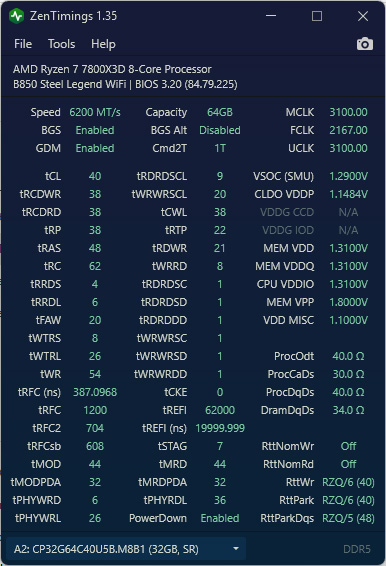
Benchmark values DDR5-6200 max …
AIDA Cache & Memory Benchmark
Read rate: 67,720 MB/s (+37%)
Write rate: 91,090 MB/s (+38%)
Copy rate: 67,720 MB/s (+37%)
Latency: 67.2 ns (-28%)
The individual values in the AIDA 64 benchmark were improved by around 1% and are now 28% to 38% better than at the start.
Time Spy CPU-Score: 13.215 Points (+15%)
The Time Spy CPU benchmark cannot even gain 0.3%.
Ryzen DRAM-Calc Benchmark: 72.7 seconds (-28%)
The Ryzen DRAM-Calc benchmark benefits the most and gains just another 1.3 seconds or 1.8% compared to our quick tuning.
Overview of the measurement results …
The following overview provides a clear overview of the performance improvements achieved by the individual measures.
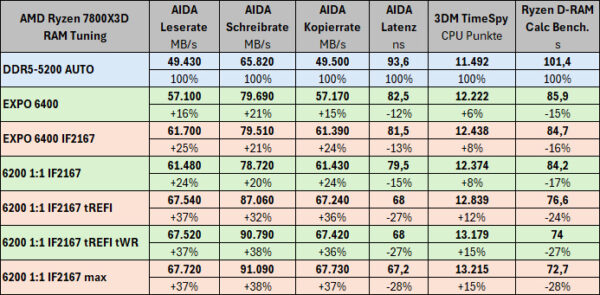
Conclusion on DDR5 memory tuning …

